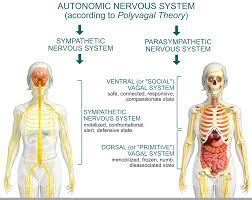Vegas...No Vagus! What does the vagus nerve do?
- Kimberly Miller
- Jan 23, 2022
- 3 min read
I recently read the book Accessing the Healing Power of the Vagus Nerve by Stanley Rosenberg. It is actually a pretty easy read for the layperson even though there is a lot of medical information.
The vagus nerve is the cranial nerve that allows us to regulate when we are in a situation of fight or flight. Often times we look at a situation as threatening even though it may not be. It may have been threatening in the past and our body just relives that moment. Sometimes we aren’t able to properly regulate and respond to the situation because the front branch of our vagus nerve is not functioning correctly.
In the past it was thought that there were only two reactions and two neural pathways that regulated us. Fight or flight or rest and digest. However, this book reveals there is actually a third regulator that only higher functioning mammals have ,aka humans .
It has been found that we have 3 nerve branches that affect our reactions to “dangerous” information.
The spinal accessory nerve that causes us to go into fight or flight and be ready to face the problem or run away
The second branch is the dorsal or “back” branch of the vagus nerve. This branch activates when we do not think that fight or flight will be enough. This causes disengagement or disassociation or in animals the freeze or faint response. In a sense we play dead to avoid the situation.
The third branch is possibly the most important and the branch now being more studied. This branch is the ventral “front” branch of the vagus nerve. Rosenberg identifies this branch as the social engagement branch. It, along with other cranial nerves, helps the person regulate and determine if there is a true threat.
Animals without the ventral branch react to a threat with fight, flight, or freeze/play dead. When the event is over they go back with their lives as if nothing happened. However, when humans have an event like this, they are able to remember it and it can wreak havoc on their body and mind for quite some time or if forgotten can return with a trigger.
When this social engagement portion of the nerve is not functioning properly it can cause a host of problems including anxiety, depression, bipolar disorder, ADHD, autism, and others.
How can I regulate the ventral branch on my own?
In his book Rosenberg outlines some easy self-help exercises for regulating the vagus nerve.
First of all you can test to see if the vagus nerve is or is not functioning properly by looking in the back of your throat at the arches on either side of your uvula “the flap of skin that hangs down”. If the arches are not equal on both sides when making the “ah ah ah” sound it more than likely in not functioning properly.
So how to regulate?
First exercise is to lay on your back with your fingers interlocked and surrounding the occiput “ the bump on the back of your head near the top of your neck.” Hold this position with your head straight and move your eyes to the right. Continue to look to the right until you yawn, swallow, or sigh. Now move your eyes to the center and then to the left. Again hold your gaze to the left until you yawn, swallow, or sigh. That’s it!
Another exercise is called the salamander. Either seated with your chest out and curve in low back or on all fours tilt your ear toward your right shoulder and look to the right. Hold that position for 30-60 seconds. Now do the same thing to the left and gaze to the left.
The area surrounding the occiput that houses the vagus nerve can also be released by a “body work” therapist like myself
So if you suffer from stress, anxiety, depression…. Consider reading this book and completing these exercises. What can it hurt









Comments